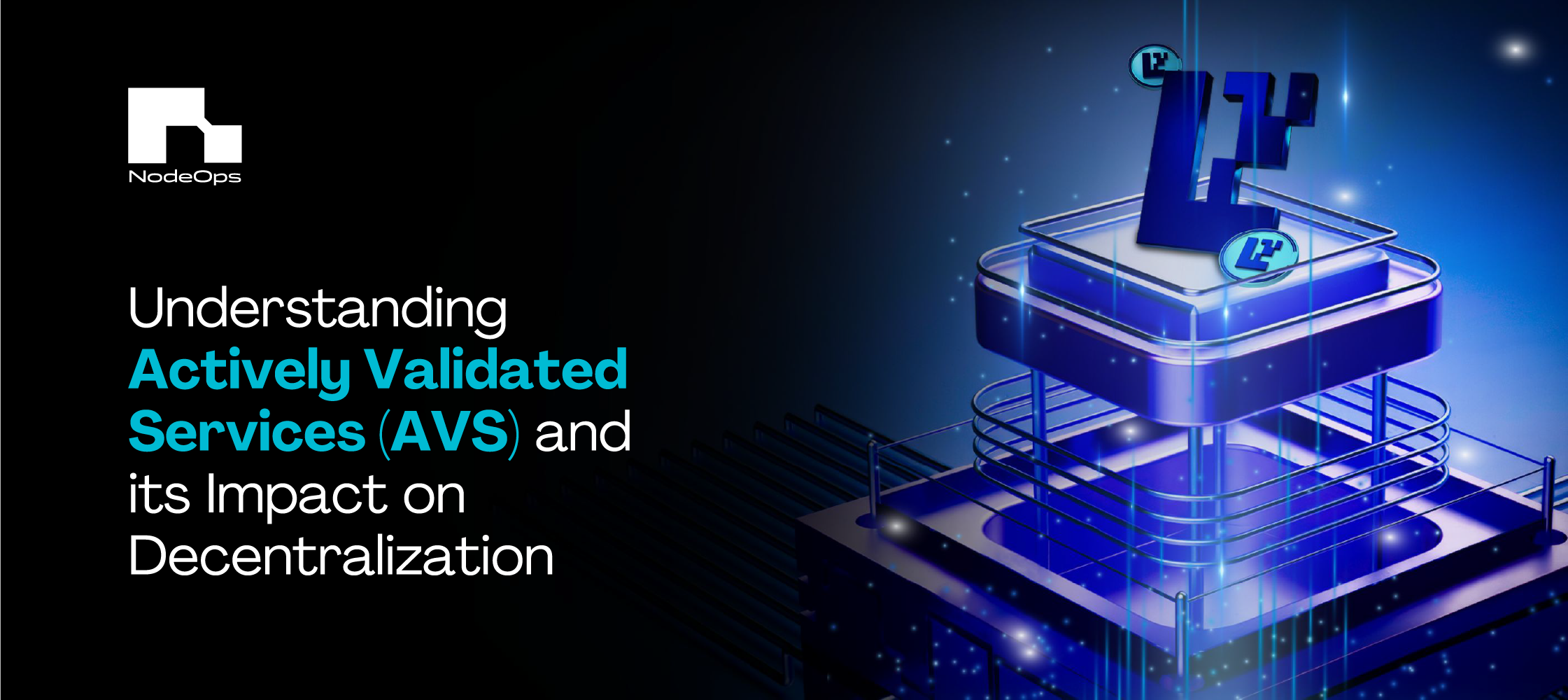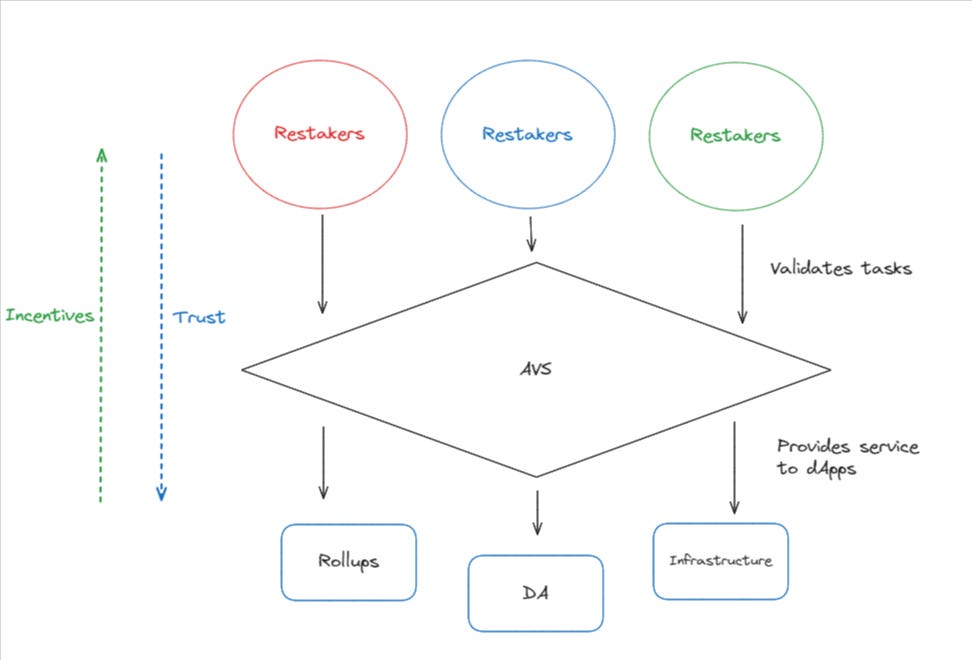Understanding Actively Validated Services (AVS) and its Impact on Decentralization
 NodeOps
NodeOps
In the rapidly evolving domain of blockchain technology, decentralization has emerged as a crucial structure for innovation, security, and trust. As enterprises and companies shift to decentralization, the need for robust validation mechanisms is also increasing. Actively Validated Services (AVS) is a transformative approach that enhances the efficiency of decentralized systems.
This blog explores AVSs, their benefits to decentralized networks, and their landscape. Read further as we uncover its potential to reshape the future of blockchain technology and decentralization.
What is AVS on EigenLayer?
Launched in 2023, EigenLayer is a groundbreaking protocol built on Ethereum that introduces restaking. By enabling the restaking of staked Ethereum (ETH), EigenLayer empowers stakers to contribute to the security of multiple blockchain applications simultaneously, while earning additional rewards in the process. At the heart of EigenLayer’s network is the AVS, which plays a crucial role in enhancing the security and functionality of these decentralized applications (dApps).
AVS is a term coined by EigenLayer that refers to services or applications built on top of the Ethereum blockchain and used for security and validation mechanisms. These services could include rollups, DA layers, interoperability protocols, etc. It allows Ethereum validators to use their staked assets to provide security to other applications built on EigenLayer.
Unlike typical Ethereum components, an AVS can be written in various programming languages and does not inherently run on EigenLayer. Instead, it communicates with the Ethereum and EigenLayer ecosystem through an AVS smart contract, which acts as a single point of contact for handling service validations and reward distributions.

Source: AVS-EigenLayer framework
EigenLayer is effectively a marketplace where dApps enter as AVS seeking economic security from the Ethereum blockchain. Ethereum validators provide this security by restaking their staked ETH tokens in return for rewards.
The AVS enhances the efficiency of blockchain networks by allowing validators to participate in multiple consensus layers, allowing them to secure and validate transactions across various projects. This open, innovative approach unlocks new possibilities for blockchain adoption, user engagement, and ecosystem growth in the evolving decentralized system.
By integrating with EigenLayer, AVS can leverage Ethereum’s consensus mechanisms, ensuring decentralization and secure validation. The integration simplifies the development process for Web3 projects by leveraging Ethereum's existing decentralized network.
EigenLayer is the second-largest DeFi project in the Web3 space after Lido. Today, EigenLayer has $16.59 billion worth of ETH locked, and its total value locked (TVL) has grown massively since its launch.
Impact of AVS on Decentralization
Now, let’s discuss how AVS positively impacts decentralization in Web3 space.
Unlocking permissionless innovation
Staking through EigenLayer enhances permissionless innovation by allowing the developers to create AVS without establishing their own PoS networks. The permissionless environment allows developers to innovate and create apps easily using the EigenLayer protocol. Moreover, stakers can support these innovations by restaking their assets to the AVS and providing essential crypto-economic security without any hindrances. This open access allows any user to become a restaker, ensuring decentralized economic security and growth.
Interoperability and scalability
EigenDA, the first AVS on EigenLayer, is a decentralized data availability layer that enhances Ethereum’s interoperability and scalability. By enhancing its ability to connect with other networks, Ethereum can support a wide range of dApps and services, allowing more people to engage with the network. As Ethereum overcomes its interoperability and scalability challenges, it grows more robust and decentralized by optimizing and speeding up its overall performance.
Economic incentivization
AVS on EigenLayer leverages economic incentives to encourage active user participation. Rewarding participants promotes an engaging and secure ecosystem and drives continuous growth and decentralization.
Lower barrier to entry
The AVS simplifies the process and reduces the cost of setting up a secure network, making it easier for developers to initiate their projects. This lower barrier entry aims to create more decentralized applications within the ecosystem.
Distributed validator network
With AVS, dApps now have access to the decentralized Ethereum validator network, which can be used to remove areas of centralization in them. Also, as an increasing number of AVS are created on EigenLayer, we could see an increase in the number of Ethereum validators, furthering their own decentralization.
Understanding the AVS landscape
As reported by Coinbase, on April 9, 2024, EigenLayer launched its Operator and AVS modules on the mainnet, supporting a dynamic ecosystem of over 200+ operators (as of May 2024) and 11 active AVSs (and growing). The AVS landscape segments into distinct categories based on the nature of the services:
Horizontal AVS
It provides fundamental tools and infrastructure for developers to help create new blockchains with shared security, assist with node management and staking, and distribute rewards to delegators and operators. Examples include Othentic, Blockless, Supermeta, and Anzen.
Vertical AVS
These are more specialized and focus on specific use cases such as rollup-as-a-service, DePIN, security monitoring, smart contracts policy engines, applied cryptography, ZK coprocessors and proofs, multi-party computation, MEV management services, and more. EigenDA, Caldera, Aethos, Fhenix, and eOracle are examples of vertical AVS.
Application layer
The new on-chain applications will leverage EigenLayer’s remarkable security, including rollups, liquid staking tokens (LRTs), and other finance and gaming-related dApps.
NodeOps is leading the way in addressing key challenges in node infrastructure, such as scalability, security, and operational efficiency. Our soon-to-be-launched AVS on EigenLayer will empower node operators to validate various services seamlessly and enhance decentralization. The upcoming innovation will provide numerous benefits while maintaining network integrity and safety across the ecosystem. Stay tuned for more details on how our unique AVS on EigenLayer will transform the infrastructure landscape.
The Bottomline on AVS
The arrival of Actively Validated Services on EigenLayer creates a paradigm shift in the blockchain and Web3 industry. As decentralized SaaS, AVSs aim to offer crypto-economic security, similar to how SaaS solutions transformed Web2 development. Due to the growing demand for dApps and evolving protocols, AVSs are poised to become Web3 SaaS.
NodeOps is a cutting-edge web3 infrastructure platform designed to simplify the deployment and management of blockchain nodes across multiple networks. Our mission is to empower developers and node operators with an intuitive, AI-driven set of tools and services that simplify the complexities of blockchain infrastructure. NodeOps caters to a wide range of blockchain protocols, including EigenLayer, Aethir, Celestia, XAI Games, Zora, Avail, Fuel, and various cosmos ecosystem-based L1s such as OraiChain & Archway. Thanks to its containerized on-demand infrastructure, NodeOps can scale to meet the growing needs of the blockchain ecosystem. We've raised over 125 million via our Node Sales, including CARV, Aethir, XAI, Lumoz, and more, and are currently supporting over 35 protocols with more than 31,700 nodes.
Join NodeOps today and try out one-click node deployment across our supported protocols. Further, for protocol updates, follow NodeOps on X!
Subscribe to my newsletter
Read articles from NodeOps directly inside your inbox. Subscribe to the newsletter, and don't miss out.
Written by

